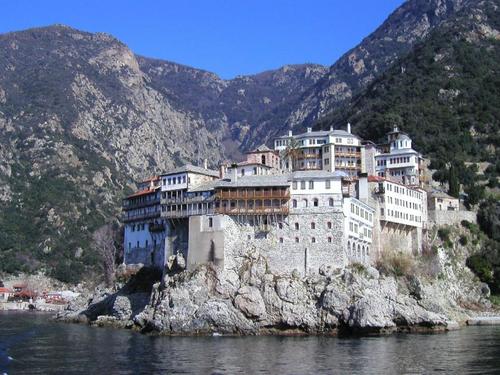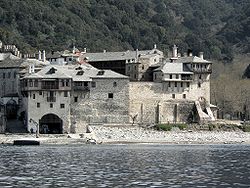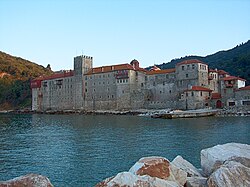One of the monasteries on Mt. Athos
Most of the inhabitants are monks of the eastern Orthodox church, formed after Constantine I in the fourth century A.D.  became the emperor of the Holy Roman Empire and moved the capitol from Rome to Constantinople, now renamed Istanbul. That led to a schism in both the early Christian church of Rome, which eventually would evolve into the Roman Catholic Church, and in the empire.  When Constantinople died,  the empire split into the eastern and western Roman empire.  As early as the fourth century,  monks of the eastern Orthodox religion, seeking a holy place for complete solitude and cloister, began migrating to  the small peninsula. Mount Athos  is a mountain on the peninsula of the same name in Macedonia, of northern Greece, called in English, "Holy Mountain". According to the athonite tradition, the Blessed Virgin Mary was sailing accompanied by St John the Evangelist from Joppa to Cyprus to visit Lazarus. When the ship was blown off course to then pagan Athos it was forced to anchor near the port of Klement, close to the present monastery of Iviron.  The Virgin walked ashore and, overwhelmed by the wonderful and wild natural beauty of the mountain, she blessed it and asked her Son for it to be her garden. A voice was heard saying "Ἔστω ὠτόπος οὖτος κλῆÏος σός καί πεÏιβόλαιον σόν καί παÏάδεισος, ἔτι δΠκαί λιμήν σωτήÏιος τῶν θελόντων σωθῆναι" (Translation: "Let this place be your inheritance and your garden, a paradise and a haven of salvation for those seeking to be saved"). From that moment the mountain was consecrated as the garden of the Mother of God and was out of bounds to all other women.[5] Politically it is known in Greece as the Self-governed Monastic State of the Holy Mountain. This World Heritage Site is home to 20 Eastern Orthodox monasteries and forms a self-governed monastic state within the sovereignty of the Hellenic Republic. Spiritually, Mount Athos comes under the direct jurisdiction of the Ecumenical Patriarchate of Constantinople.  (The tiny area is red is Mt. Athos) The peninsula, the easternmost "leg" of the larger Halkidiki peninsula, protrudes into the Aegean Sea for some 60 kilometres (37 mi) at a width between 7 to 12 km and covers an area of 335.637 square kilometres (129.59 sq mi), with the actual Mount Athos and its steep, densely forested slopes reaching up to 2,033 metres (6,670 ft). The seas around the end of the peninsula can be dangerous. In the ancient Greek history two fleet disasters are recorded: In 492BC Darius, the king of Persia, lost there 300 ships under general Mardonius (Herodotus "Histories" book VI (Erato), Aeschylus "The Persians"). In 411BC Spartans lost a fleet of 50 ships under admiral Epicleas. (Diodorus Siculus, "Bibliotheca historica" XIII 41, 1-3). Though land-linked, Mount Athos is accessible only by boat. The daily number of visitors entering in Mount Athos is restricted and all are required to obtain a special entrance permit. Only males are allowed entrance into Mount Athos, which is called "Garden of the Virgin" by monks,[2] and Orthodox Christians take precedence in the permit issuance procedure  Only males over the age of 18 who are members of the Eastern Orthodox Church are allowed to live on Athos, either as monks or as workers. There are a small number of unarmed religious guards  who are not monks, to keep order. Police and Coast Guard presence is very discreet. Residents not part of the religious communities are required to live in the peninsula's capital, Karyes. Most workers live at the place where they work. Small low class hotels exist at Karyes (administrative center) and Dafni (main port). The 2001 Greek national census counted a population of 2,262 inhabitants. The chroniclers Theophanes the Confessor (end of 8th century) and Georgios Kedrenos (11th century) wrote that the 726 eruption of the Thera volcano was visible from Mount Athos, proving that it was inhabited at the time. The historian Genesios recorded that monks from Athos participated at the 7th Ecumenical Council of Nicaea of 787. Around 860, the famous monk Efthymios the Younger came to Athos and a number of monk-huts ("skete of Saint Basil") were created around his habitation, possibly near Krya Nera. During the reign of emperor Basil I the Macedonian, the former Archbishop of Crete (and later of Thessaloniki) Basil the Confessor built a small monastery at the place of the modern harbour ("arsanas") of Hilandariou Monastery. Soon after this, a document of 883 states that a certain Ioannis Kolovos built a monastery at Megali Vigla. On a chrysobull of emperor Basil I, dated 885, the Holy Mountain is proclaimed a place of monks, and no laymen or farmers or cattle-breeders are allowed to be settled there. The next year, in an imperial edict of emperor Leo VI the Wise we read about the "...so-called ancient seat of the council of gerondes (council of elders)...", meaning that there was already a kind of monks' administration and that it was already "ancient". In 887, some monks expostulate to the emperor Leo the Wise as the monastery of Kolovos is growing more and more and they lose their peace. In 908, the existence of a Protos("First monk") is documented, who is the "head" of the monastic community. In 943, the borders of the monastic state was precisely mapped while we know that Karyes is already the capital town and seat of the administration and has the name "Megali Mesi Lavra" (Big Central Assembly). In 956, a decree offered land of about 940,000 m² (about 230 acre) to the Xiropotamou monastery, which means that this monastery was already quite big. In 958, the monk Athanasios the Athonite (Άγιος Αθανάσιος ο Αθωνίτης) arrived on Mount Athos. In 962, he builds the big central church of the "Protaton" in Karies. In the next year, with the support of his friend, Emperor Nicephorus Phocas, the monastery of Great Lavra was founded, still the largest and most prominent of the 20 monasteries existing today. It enjoyed the protection of the emperors of the Byzantine Empire during the following centuries and its wealth and possessions grew considerably. The Fourth Crusade in the 13th century brought new Roman Catholic overlords which forced the monks to complain and ask for the intervention of Pope Innocent III, until the restoration of the Byzantine Empire came. The peninsula was raided by Catalan mercenaries in the 14th century, a century that also saw the theological conflict over the hesychasm practised on Mount Athos and defended by Gregory Palamas. The Byzantine Empire was conquered in the 15th century and the newly established Islamic Ottoman Empire took its place. The Athonite monks tried to maintain good relations with the Ottoman Sultans and therefore when Murad II conquered Thessaloniki in 1430 they immediately pledged allegiance to him  In return, Murad recognized the monasteries' properties, something which Mehmed II formally ratified after the fall of Constantinople in 1453. In this way the Athonite independence was somewhat guaranteed. The 15th and 16th centuries were particularly peaceful for the Athonite community. This led to relative prosperity for the monasteries. An example of this is the foundation of Stavronikita monastery which completed the current number of Athonite monasteries. Following the conquest of the Serbian Despotate by the Ottomans many Serbian monks came to Athos. The extensive presence of Serbian monks is depicted in the numerous elections of Serbian monks to the office of the Protos during the era. Sultan Selim I was a substantial benefactor of the Xiropotamou monastery. In 1517, he issued afatwa and a Hatt-i Sharif ("noble edict") that "the place, where the Holy Gospel is preached, whenever it is burned or even damaged, shall be erected again." He also endowed privileges to the Abbey and financed the construction of the dining area and underground of the Abbey as well as the renovation of the wall paintings in the central church that were completed between the years 1533-1541.[7] Despite the fact that most time the monasteries were left on their own, the Ottomans heavily taxed them and sometimes they seized important land parcels from them. This eventually culminated in an economic crisis in Athos during the 17th century. This led to the adoption of the so called "idiorrhythmic" lifestyle (a semi-eremitic variant of Christian monasticism) by a few monasteries at first and later, during the first half of the 18th century, by all. This new way of monastic organization was an emergency measure taken by the monastic communities to counter their harsh economic environment. Contrary to the cenobitic system, monks in idiorrhythmic communities have private property, work for themselves, they are solely responsible for acquiring food and other necessities and they dine separately in their cells, only meeting with other monks at church. At the same time, the monasteries' abbots were replaced by committees and at Karyes the Protos was replaced by a four member committee.[8] Russian tsars, and princes from Moldavia, Wallachia and Serbia (until the end of the 15th century) helped the monasteries survive with large donations. The population of monks and their wealth declined over the next centuries, but were revitalized during the 19th century, particularly by the patronage of the Russian government.  As a result, the monastic population grew steadily throughout the century, reaching a high point of over 7000 monks in 1902[9]. In 1912, during the First Balkan War, the Ottomans were forced out by the Greek Navy. Greece claimed the peninsula as part of the peace treaty of London signed in May 30, 1913. As a result of the shortcomings of the Treaty of London, the Second Balkan War broke out between the combatants in June 1913. A final peace was agreed at the Treaty of Bucharest on 10 August 1913. In June 1913 a small Russian fleet, consisting of the gunboat Donets and the transport shipsTsar and Kherson, delivered the archbishop of Vologda, and a number of troops to Mount Athos to intervene in the theological controversy over imiaslavie (a Russian Orthodox movement). The archbishop held talks with the imiaslavtsy and tried to make them change their beliefs voluntarily, but was unsuccessful. On July 31 the troops stormed the St. Panteleimon Monastery. Although the monks were not armed and did not actively resist, the troops showed very heavy-handed tactics. After the storming of St. Panteleimon Monastery the monks from the Andreevsky Skete (Skiti Agiou Andrea) surrendered voluntarily. The military transport Kherson was converted into a prison ship and several imiaslavtsy monks were sent to Russia. After a brief diplomatic conflict between Greece and Russia over sovereignty, the peninsula formally came under Greek sovereignty after World War I. The self-governed region of the Holy Mountain, according to the Decree passed by the Holy Community on the 3rd October 1913 and according to the international treaties of London(1913), Bucharest (1913), Neuilly (1919), Sèvres (1920) and Lausanne (1923), is considered part of the Greek state. The Decree, "made in the presence of the Holy Icon of Axion Estin", stated that the Holy Community recognised the Kings of Greece as the lawful sovereigns and "successors on the Mountain" of the "Emperors who built" the monasteries and declared its territory as belonging to the then Kingdom of Greece. Later a "Special Double Assembly" of the Holy Community in Karyes passed the "Constitutional Charter" of the Holy Mountain, which was ratified by the Greek Parliament. This regime originates from the "self-ruled monastic state" as stated on a chrysobull parchment signed and sealed by the Byzantine Emperor Ioannis Tzimisces in 972. This important document is preserved in the House of the Holy Administration in Karyes. The self-rule of the Holy Mountain was later reaffirmed by the Emperor Alexios I Komnenos in 1095. According to the constitution of Greece,[10] Mount Athos (the "Monastic State of Hagion Oros") is, "following ancient privilege", politically self-governed and consists of 20 main monasteries which constitute the Holy Community, and the capital town and administrative centre, Karyes, also home to a governor as the representative of the Greek state. The governor is an executive appointee. The status of the Holy Mountain and the jurisdiction of the Hagiorite institutions were expressly described and ratified upon admission of Greece to the European Union (then the European Community). On September 12, 2004, the Eastern Orthodox Patriarch of Alexandria, Peter VII, was killed, together with 16 others, in a helicopter crash in the Aegean Sea off the peninsula. The Patriarch was heading to Mount Athos. The cause of the crash remains unknown. The monasteries of Mount Athos have a history of opposing ecumenism, or movements towards reconciliation between the Orthodox Church of Constantinople and the Roman Catholic Church. The Esphigmenou monastery is particularly outspoken in this respect, having raised black flags to protest against the meeting of Patriarch Athenagoras I of Constantinople and Pope Paul VI in 1972 . Esphigmenou was subsequently expelled from the representative bodies of the Athonite Community. The conflict escalated in 2002 with Patriarch Bartholomew I of Constantinople declaring the monks of Esphigmenou an illegal brotherhood and ordering their eviction; the monks refuse to be evicted, and oppose their replacement with a new brotherhood. After reaching a low point of just 1145 mainly elderly monks in 1971, the monasteries have been undergoing a steady and sustained renewal. By the year 2000, the monastic population had reached 1610, with all 20 monasteries and their associated sketes receiving an infusion of mainly young well-educated monks. Many younger monks possess university education and advanced skills that allow them to work on the cataloguing and restoration of the Mountain's vast repository of manuscripts, vestments, icons, liturgical objects and other works of art, most of which remain unknown to the public because of their sheer volume. Projected to take several decades to complete, this restorative and archival work is well under way, funded by UNESCOand the EU, and aided by many academic institutions.Early Christianity

Historical documents on ancient Mount Athos history are very few. It is certain that monks have been there since the 4th century, and possibly since the 3rd. During Constantine I's reign (324-337) both Christians and pagans were living there.
During the reign of Julian the Apostate (361-363), the churches of Mount Athos were destroyed, and Christians hid in the woods and inaccessible places. Later, during Theodosius I's reign (383-395), the pagan temples were destroyed.
The lexicographer Hesychius of Alexandria states that in the 5th century there was still a temple and a statue of "Zeus Athonite". After the Islamic conquest of Egypt in the 7th century, many orthodox monks from the Egyptian desert tried to find another calm place; some of them came to the Athos peninsula. An ancient document states that monks "...built huts of wood with roofs of straw (...) and by collecting fruit from the wild trees were providing themselves improvised meals..."[6]
[edit]Byzantine era: the first monasteries
[
[edit]Modern times
[
/p>








